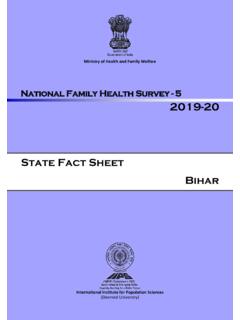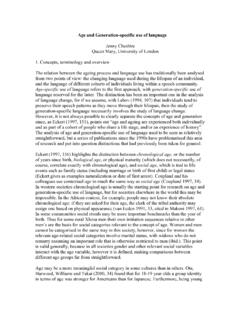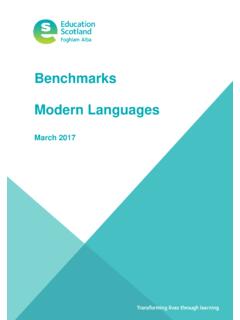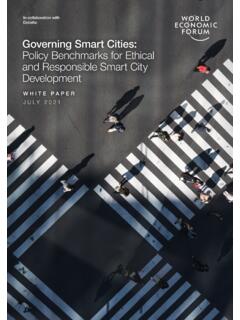Transcription of Global Trends in Language Learning in the 21st Century
1 Global Trends in Language Learningin the 21st Century2010 This report has been published by Onate Press, an imprint of Eaton International Consulting Inc. Its purpose is to provide researchers, educational leaders and teachers with an understanding of current Trends in Language : Sarah Elaine Eaton, date: June 2010 ISBN: 978-0-9733594-6-6 The guide is available at copies can be ordered to distribute to colleagues or students. E-mail citation for this documentEaton, (2010). Global Trends in Language Learning in the Twenty-first Century . Calgary: Onate | 2 | Global Trends in Language Learning in the 21st CenturyAbout Eaton International Consulting (EIC) Inc. and Onate PressEIC Inc. was founded in 2001 to provide strategic leadership consulting and coaching services, conduct research and offer professional development for leaders in education and the voluntary and non-profit sectors.
2 We specialize in educational management and leadership with a particular focus on Language and Press (2010) is a publishing imprint of Eaton International Consulting of Summary s out? , hollow promises that can't be proven. that Learning languages is easy. teacher attitudes. about cutbacks and lack of funding. labs. s in? , provable demonstrations Learning . 11 Frameworks, benchmarks and other asset-based ..approaches to assessment. 12 Individualized, customizable, learner-centred ..approaches. technology for Language Learning . Language Learning to leadership skills. 15 Showing funders the impact their investment has on our ..students, our communities and our world. and resources | 3 | Global Trends in Language Learning in the 21st CenturyAcknowledgementsI gratefully acknowledge my colleagues at the Language Research Centre at the University of Calgary.
3 It is through dialogues and conversations that research such as this is inspired. In particular, I thank my friend and colleague, Dr. Emily Gillen, a visionary in the field of technology for Language Learning , who is leading the way with her Language students in terms of incorporating technology into the colleagues, Dr. Kelly Edmonds, Dr. Sandra Hoenle, Dr. Mary O Brien and Dr. Nick ekulin also deserve special mention, as they have, over the years, also taught me much about how technology has been - and likely will continue to be - used in the Language mentor, Dr. J. Timothy Goddard, remains a source of guidance and insight. He taught me to think globally, rather than locally, always seeking knowledge beyond my own boundaries, be they personal, intellectual, geographical or few colleagues in Language Learning and literacy deserve special mention, most notably Dr.
4 Christine Shea, Courtney Hare, Karen Dodge, Jacquelyn Clydesdale, Audrey Gardner, Janice Aubry, Dr. Wei Cai and Brent Novodvorski, each of whom is an accomplished teacher and leader in their own of this research was conducted during the first half of 2010, when I had the privilege of working with Heather Ainsworth as a fellow researcher at Eaton International Consulting Inc. Although Heather did not work on this project directly, having her input about Trends in Learning in general was extremely helpful. Her position was funded by the Career Focus Program, of Service Canada. We are indebted to Jennifer Greengrass, Programs Officer/Agente des programmes, Labour Market and Social Development Programs/Programmes du march du travail et de d veloppement social, Service Canada, British Columbia/Alberta/Territories, R gion de la , de l'Alberta et des Territoires for her help and support throughout the , thank you to Todd Maki for his ongoing support, patience and | 4 | Global Trends in Language Learning in the 21st CenturyExecutive SummaryThis report is intended to stimulate discussion, provoke thought and generate reflective responses among its readers.
5 Today s Language classroom is vastly different from that of the mid- to late 20th Century . The report offers a meta-analysis of recent research which provided the means to identify current and emerging Trends in the field. Informed by this research, some identified Trends that are shaping the 21st Century Language classroom are:What s outVague, hollow promises that can't be that Learning languages is teacher about cutbacks and lack of s inClear, provable demonstrations of , benchmarks and other asset-based approaches to , customizable, learner-centred the value of Language Learning through stories and technology for Language Language Learning to leadership funders the impact their investment has on our students, our communities and our short, the focus in Language education in the twenty-first Century is no longer on grammar, memorization and Learning from rote, but rather using Language and cultural knowledge as a means to communicate and connect to others around the globe.
6 Geographical and physical boundaries are being transcended by technology as students learn to reach out to the world around them, using their Language and cultural skills to facilitate the connections they are eager to : Eaton, (2010). Global Trends in Language Learning in the Twenty-first Century . Calgary: Onate | 5 | Global Trends in Language Learning in the 21st CenturyIntroductionThe field of Language education is changing at an ever-increasing rate. Traditional notions of education are giving way to newer, more innovative ways of thinking about how we learn, teach and acquire knowledge. This research report has been prepared to help educational leaders and teachers understand current Trends in Language education. This includes, but is not limited to: English as a Second or Other Language (ESL / ESOL)Second and Other Languages in general (SL)Literacy and Language artsThis work is by no means exhaustive.
7 It is, rather, a meta-analysis of the Trends that can be identified based on current research. Its intention is to stimulate discussion, provoke thought and generate reflective responses. It is worth stating that one assumption underpinning this research is that students, and their needs, hopes and aspirations must be kept at the heart of Language Learning and are encouraged to share this report with colleagues, use it as pre-reading material for professional development sessions and staff meetings. As educational leadership guru, Michael Fullan, points out, Leaders Learning from each other raises the bar for all. Since much Learning takes place through conversations (Siegrist, 2000), school leaders and teachers are urged use this report as a think piece to inspire dialogue with other educators and those with a keen interest in the future of Language | 6 | Global Trends in Language Learning in the 21st CenturyWhat s out?
8 Vague, hollow promises that can't be s tech-savvy students have a world of resources and information at their finger tips. They balk at vague promises that Language Learning will get them better jobs. Today's job market requires more than a knowledge of another Language . In the twenty-first Century , a comprehensive essential skill set is needed for employment. This includes competence in areas beyond languages such as:numeracythinking skillscomputer usethe ability to work well with others (Human Resources and Skills Development Canada, )Today s young people understand that lifelong Learning is going to be the norm for them. The idea that Learning a second Language is a ticket to a higher-level job or an international position is an outdated myth. Today knowledge of another Language is one of a number of skills which may help an individual acquire meaningful employment, not a guarantee to a better job or a career | 7 | Global Trends in Language Learning in the 21st CenturySaying that Learning languages is Century students are tech-savvy, worldly and quick to shrug off what cannot be proven.
9 Today s students see right through false claims that Learning a Language is easy. The notion that one can play an audio program while drifting off to sleep and wake up fluent, an idea that once seemed seductively easily, is now dismissed as a are ways to make Learning languages fun or more enjoyable, but that does not mitigate the need for continuous and dedicated the 10,000 hours to become an expert rule, brought alive by Malcolm Gladwell in his book, Outliers. In the book Gladwell explains the research behind the notion that true expertise is achieved after an individual has invested 10,000 hours in Learning or practicing a skill. This may be a sport, a musical instrument or the study of something. If we consider fluency to be the same as being an expert in speaking a Language , then a learner may well invest 10,000 hours in their Language studies to attain fluency.
10 People will shake their heads when they hear that. No one wants to believe it really requires that much challenges of Learning another Language are immense. Yet millions have achieved some degree of fluency in at least one other Language . Those who achieve true fluency do so because they put in dedicated, consistent effort over a long period of time. Claiming otherwise is tantamount to | 8 | Global Trends in Language Learning in the 21st CenturyAuthoritative teacher 1971 a scholar by the name of Robert Nisbet claimed that the man of knowledge and his pursuits were sacred . Much has changed in years since professor Nisbet wrote those words. While teachers are still regarded as knowledgeable, they are no longer revered as sacred. While some may lament, and even resist this notion, it is safe to say that teachers no longer enjoy the aura of the sacred , as Nisbet calls today's world young people are very aware that sometimes they know more than many of the "over-30s", at least when it comes to technology.


















